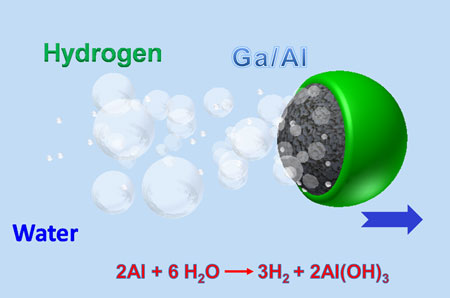| Posted: Aug 23, 2012 | |
Micro- and nanomotors powered by water as the sole fuel source (w/video) |
|
| (Nanowerk Spotlight) Man-made micro- and nanoscale motors have received a tremendous recent interest owing to their great potential for diverse potential applications, ranging from targeted drug delivery, microchip diagnostics or environmental remediation. Particular attention has been given to self-propelled chemically-powered micro/nanoscale motors, such as catalytic nanowires (read more: ""Another nanotechnology step towards 'Fantastic Voyage'"), microtube engines (read more: "Microbots transport, assemble and deliver micro- and nanoscale objects") or spherical Janus microparticles (read more: "Novel motor system powered by polymerization"). | |
| "Although significant progress over the past 10 years has greatly advanced the capabilities of these tiny man-made machines, such catalytic motors have predominantly relied on an external hydrogen peroxide fuel that impedes many practical applications," Joe Wang, Distinguished Professor, Department of Nanoengineering at the University California San Diego, tells Nanowerk. "Extending the scope of chemically-powered nanomotors to diverse operations and new environments requires the identification of new in situ fuels in connection to new catalytic materials and reactions. Obviously, water is the ideal choice as fuel for the majority of practical nanomachine applications." | |
| In new work, reported in the August 14, 2012 online issue of ACS Nano ("Water-Driven Micromotors"), Wang and his team (Wei Gao, Allen Pei) have now demonstrated the first example of a water-driven bubble-propelled micromotor that eliminates the requirement for the common hydrogen peroxide fuel. | |
| Although the water-splitting reaction has been used before to drive bipolar-electrochemical macroscale motors under an external electrical field (see paper in Nature Communications: "Electric field-induced chemical locomotion of conducting objects"), it has not been used for the locomotion of self-propelled chemically powered micromotors. | |
| By presenting the first example of a chemically-powered micromotor propelled autonomously using water as the sole fuel source, the team greatly expands the scope of applications and environments of chemically powered nanomachines (in previous work, Wang and his team already demonstrated hydrogen-bubble-propelled zinc-based microrockets that rely on strong acids as fuels). | |
| In particular, as Wang explains, "these water-driven micromotors could have a profound impact on diverse biomedical or industrial applications of micromotors, ranging from targeted drug delivery to microchip diagnostics, where the use of the common peroxide fuel is not desirable or possible." | |
 |
|
| The water-driven Janus micromotor is composed of a partially coated Al–Ga binary alloy microsphere. The dark hemisphere (left) represents the Al-Ga alloy, while the green area (right) corresponds to the asymmetric Ti coating on one side of the sphere. The ejection of hydrogen bubbles from the exposed Al-Ga alloy hemisphere side, upon its contact with water, provides a powerful directional propulsion thrust. (Image: Dr. Wang, UC San Diego) | |
| To accomplish the goal of using water for generating the bubble-thrust, essential for an efficient autonomous movement, the researchers have focused here on the use of aluminum to reduce water to hydrogen. For this purpose they identified the most appropriate aluminum-alloy composition. They designed a new bubble-propelled spherical Janus micromotor based on coating one side of an Al-Ga microparticle with a titanium layer (see figure above) and developed a new microcontact route for fabricating such water-propelled Al-Ga/Ti microparticles. | |
| Specifically, the fabrication process involved these major steps: Aluminum particles (average size 20 µm) and liquid gallium are spread onto separate glass slides at a 1:1 mass ratio. The two slides were then pressed together until an Al-Ga alloy formed via microcontact mixing. During this period, gallium penetrated into the aluminum particles to form the outer alloy layer. Subsequently, one side of the Al-Ga microparticles was coated with a titanium layer via e-beam evaporation to form the asymmetric Janus microstructure. Brief sonication allowed the separation of the micromotors from the glass slides. | |
| Once the microparticles come in contact with water – or other fluids such as biological media – a rapid reaction between the aluminum alloy and water leads to a spontaneous generation of hydrogen bubbles. This ejection of hydrogen bubbles from the exposed Al-Ga alloy hemisphere side provides a powerful directional propulsion thrust (see video below). | |
| The strong momentum of the bubble ejection propels the micromotor at a remarkable speed of 3 millimeters per second, which corresponds to 150 body lengths per second. | |
| Wang says that future efforts will aim at further improving the propulsion behavior of water-driven micromotors by enhancing the alloy reactivity via a judicious control of its microstructure and composition. | |
| "We will also investigate new water-splitting catalytic reactions and materials, that would offer extended motor lifetimes and/or higher efficiency, and will demonstrate practical applications of these water-powered micromotors." | |
 By
Michael
Berger
– Michael is author of three books by the Royal Society of Chemistry:
Nano-Society: Pushing the Boundaries of Technology,
Nanotechnology: The Future is Tiny, and
Nanoengineering: The Skills and Tools Making Technology Invisible
Copyright ©
Nanowerk LLC
By
Michael
Berger
– Michael is author of three books by the Royal Society of Chemistry:
Nano-Society: Pushing the Boundaries of Technology,
Nanotechnology: The Future is Tiny, and
Nanoengineering: The Skills and Tools Making Technology Invisible
Copyright ©
Nanowerk LLC
|
|
|
Become a Spotlight guest author! Join our large and growing group of guest contributors. Have you just published a scientific paper or have other exciting developments to share with the nanotechnology community? Here is how to publish on nanowerk.com. |
|
